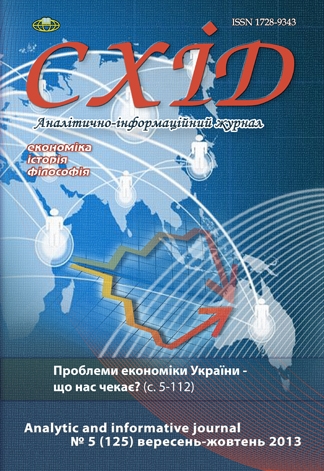Foresight as a methodology of designing the future
DOI:
https://doi.org/10.21847/1728-9343.2013.5(125).18951Keywords:
foresight, strategic planning, forecasting, social and economic development, innovation activitiesAbstract
This article is devoted to the problems of planning and forecasting the future. The authors investigate one of the methods of strategic planning, namely foresight. They research various approaches to the definition of the term "foresight", formulate its role. They also investigate the characteristics of foresight and find the differences between foresight and other instruments of studying the future. The authors found that foresight is a natural human activity, which is always carried by individuals and society out. However, it is now formalized into an effective method and is used by governments, regions and other stakeholders to create the desired image of the future and determine strategies to achieve it, using the innovations. The technology of foresight can not only "look" into the future, but also to "make" the future according to the goals. Foresight can be used to develop long-term strategies and plans for individual businesses, regions and the entire state.
Downloads
References
Федулова Л. І. Форсайт: сучасна методологія технологічного прогнозування / Л. І. Федулова // Економіка і прогнозування. - 2008. - № 3. - С. 106-120.
Панченко І. А. Форсайт: методологія технологічного прогнозування / І. А. Панченко // Держава та регіони. Серія "Економіка та підприємництво". - 2011. - № 3. - С. 30-35.
Ben R. Martin. Technology foresight in a rapidly globalizing / Ben R. Martin // International Practice in Technology Foresight. - Vienna : UNIDO, 2002. - Р. 14.
Schwarz J.-O. Assessing the future of futures studies in management / J.-O. Schwarz // Futures. - 2008. - Vol. 40. - Iss. 3. - Рр. 237-246.
Международный научно-образовательный Форсайт-центр [Електронний ресурс]. - Режим доступу : http://foresight.hse.ru.
Форсайт в Україні: історія, етимологія [Електронний ресурс]. - Режим доступу : http://www.uintei.kiev.ua/foresight/ua/foresight.php?id=1&id66932.
Афанасьев Г. Э. Что такое форсайт? Попытки определения [Електронний ресурс] / Г. Э. Афанасьев. - Режим доступу : http://stra.teg.ru/library/global/Prognoz/foresight/4/print.
Rohrbeck R. Corporate Foresight: Towards a Maturity Model for the Future Orientation of a Firm / R. Rohrbeck // Springer Series: Contributions to Management Science. - Heidelberg ; New York. - 2010.
Benchmarking Report - Strategic Foresight in Multinational Companies. Report of the European Corporate Foresight Group / [R. Rohrbeck, S. Mahdjour, S. Knab, T. Frese]. - Berlin, 2009.
Осипов В. М. Роль форсайта в управлінні субрегіоном / В. М. Осипов, І. Л. Парасюк, О. О. Ворожейкін // Економічні інновації. - 2012. - Вип. 47. - С. 197-205.
Кваша Т. К. Вибір пріоритетних напрямків науково-технологічного розвитку з використанням форсайту / Т. К. Кваша // Проблеми розвитку інформаційного суспільства : матеріали II міжнародного форуму. - К. : УкрІНТЕІ, 2010. - Ч. II. - С. 78-82.
Міжнародний практичний посібник з регіонального форсайту, 2001 [Електронний ресурс]. - Режим доступу : http://www.sworld.com.ua/index.php/ru/economy/business-sectors-of-the-economy/3060-aksonova-om.
REFERENCES
Fedulova L. I. (2008), Forsait: Suchasna metodolohiia tekhnolohichnoho prohnozuvannia [Foresight: modern methodology of technological forecasting], Economics and Forecasting, 3, pp. 106-120 (ukr).
Panchenko I. A. (2011), Forsait: metodolohiia tekhnolohichnoho prohnozuvannia [Foresight: the methodology of technological forecasting], State and Regions, 3, pp. 30-35 (ukr).
Ben R. Martin (2002), Technology foresightin a rapidly globalizing, International Practice in Technology Foresight, UNIDOр, Vienna, p. 14 (engl).
Schwarz J.-O. (2008), Assessing the future of futures studies in management, Futures, Vol. 40, Iss. 3, pp. 237-246 (engl.)
Mezhdunarodnyy nauchno-obrazovatelnyy Forsayt-tsentr [International Research and Educational Foresight Centre], available at: http://stra.teg.ru/library/global/ Prognoz/foresight/4/print (rus).
Forsait v Ukraini: istoriia, etymolohiia [Foresight in Ukraine: history, etymology], available at: http://www.uintei.kiev.ua/foresight/ua/foresight.php?id=1&id66932 (ukr).
Afanasyev G. E., Chto takoye forsayt? Popytki opredeleniya [What is Foresight? Attempts to determine], available at: http://stra.teg.ru/library/global/Prognoz/foresight/4/print (rus).
Rohrbeck R. (2010), Corporate Foresight: Towards a Maturity Model for the Future Orientation of a Firm, Springer Series: Contributions to Management Science, Heidelberg and New York (engl.)
Rohrbeck R., Mahdjour S., Knab S., Frese T. (2009), Benchmarking Report – Strategic Foresight in Multinational Companies. Report of the European Corporate Foresight Group, Berlin (engl.)
Osypov V. M. (2012), Rol forsaita v upravlinni subrehionom [The role of foresight in Subregion managing], Economic innovations, 47, pp. 197-205 (ukr).
Kvasha T. K. (2010), Vybir priorytetnykh napriamkiv naukovo-tekhnolohichnoho rozvytku z vykorystanniam forsaitu [Selecting the priority areas of scientific and technological development using Foresight], Challenges of the Information Society: the materials of II International Forum, Part 2, pp. 78-82 (ukr).
International practical guide to Regional Forsythe, 2001, available at: http://www.sworld.com.ua/index.php/ru/economy/business-sectors-of-the-economy/3060-aksonova-om (ukr).
Downloads
Published
How to Cite
Issue
Section
License
Copyright (c) 2013 Serhiy Bogachov, Olena Solovtsova

This work is licensed under a Creative Commons Attribution-NonCommercial-NoDerivatives 4.0 International License.
1. Authors bear responsibility for the accuracy of facts, quotations, numbers and names used.
2. Manuscripts are not sent back.
3. The publisher does not always agree with the authors' opinion.
4. The authors reserve the right to authorship of the work and pass the first publication right of this work to the journal under the terms of a Creative Commons Attribution-NonCommercial-NoDerivatives 4.0 International License. This license allows others to distribute (copy) the published work for non-commercial purposes, provided there is mandatory attribution to its authors and a link to the first publication in our journal.
5. The authors have the right to conclude separate supplement agreements that relate to non-exclusive work distribution in the form in which it has been published by the journal (for example, to upload the work to the online storage of the journal or publish it as part of a monograph), provided that the reference to the first publication of the work in this journal is included.

